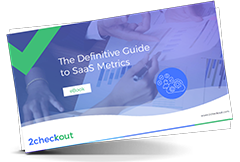Updated in May, 2022.
When measuring your success as a SaaS business, Annual Recurring Revenue (ARR) is an invaluable metric. Not only does ARR help you calculate your business revenue for that one-year period, but it also helps predict future revenue and growth and how much momentum you may be able to count on with sales, renewals, and upgrades, all of which can help you strategize for the upcoming fiscal year.
What is ARR and what does it mean?
The acronym “ARR” stands for “Annual Recurring Revenue,” and is the money that comes in each year for the life of a subscription or contract. For example, if your subscriber has a three-year subscription for $18,000, the ARR is $6,000; that is the revenue that can be counted on for each of those three years.
How is ARR different from MRR?
ARR is calculated for annual terms, with a one-year minimum, so subscriptions with less than one-year terms shouldn’t be recorded in ARR. Shorter term subscriptions should be calculated as monthly recurring revenue (MRR), because they are month-to-month and could possibly be cancelled without warning (or obligation from the subscriber). However, don’t get confused: some contracts are billed monthly but require a long-term contract, and therefore the ARR formula is applicable. Nevertheless, MRR can also provide an important metric for SaaS businesses, and answers other valuable questions.
How should I calculate ARR, and what should be included (or excluded) from the calculation?
You may calculate the ARR value for any subscriptions that have a contract that is at least one year. Then, the guideline for which formula to use is determined by the billing agreement:
- Subscriptions Billed Monthly:
(total contract cost) x (12/total duration of contract in months)
Example: Your subscriber commits to a 24-month agreement for $20,000. Your calculation will be ($20,000) x (12/24) = $10,000. Your ARR for that subscription is $10,000.
- Subscriptions Billed Annually:
(total contract cost) / (time in years)
Example: Your subscriber commits to a 3-year agreement for $30,000. Your calculation will be ($30,000)/3. Your ARR for that subscription is $10,000.
What to include and exclude? Your ARR calculation should include invoices, upgrade revenue, and downgrade revenue. Set-up fees, training and support, credit adjustments, non-recurring add-ons, and one-time charges or late fees should NOT be included in your ARR calculation.

Is ARR higher than revenue?
Annual Recurring Revenue is not typically higher than revenue, overall, because it is subscription based, and doesn’t include one-time charges or late fees (which are counted as revenue). It is expected that the amount you calculate for ARR is lower than the overall revenue.
What additional insights can ARR calculation give my business?
ARR can also show you how your accounts are performing over time. Calculating ARR regularly as a matter of course will ensure that any important changes in contracts – for better or for worse – will be immediately apparent and can be addressed quickly if necessary.
Understanding your average ARR can also help you calculate possible churn more reliably than many other metrics, telling you not just how many customers you are losing in a given month or year, but how much lost revenue translates from those customers. The opposite is also true: calculating ARR allows you to calculate expansion revenue, which can be critical for long-term growth.
Additionally, you can closely examine ARR segmented by new customers, existing customers who renew, and the incremental increases in ARR from upgrades and add-ons, all of which can help shape your coming year’s sales and marketing strategies.
What are some of the specific potential benefits of measuring ARR?
1. It provides a clear picture of a business’ overall health. Knowing where your company is performing well and where it’s lacking can help you strategize to improve your bottom line and make your company run more efficiently.
2. It can increase revenue. Having an accurate measurement of your ARR also provides insight into what is working with customers (and what isn’t) and can guide your cross-selling and up-selling decision making.
3. It helps predict revenue. If you know the value of renewals and the cost of churn/lost customers, you can more easily manage expenses.
4. It can provide valuable information for your investors. The predictability and systematic nature of a subscription service over one-time sales can be very reassuring to investors.

Additionally, knowing your Annual Recurring Revenue rates can help you measure your relationships with your customers. Customers who are willing to agree to an ongoing relationship/subscription may be signifying their confidence and trust in your brand. On the other hand, if you see a high number of customers choosing shorter-term contracts (monthly, for instance), they may need something to lure them into a longer-term contract.
Although calculating annual revenue is obviously more straightforward with a traditional product that depends on a single purchase model, it’s worth the time and effort for SaaS businesses to make this a priority. However, it can be easy for SaaS companies to incorrectly measure their ARR. A recent poll of 50 SaaS companies conducted by ProfitWell revealed that 2 out of 5 were including or excluding items in their annual recurring revenue calculations. This can be risky, giving you a false picture of the health of your business.
Keep reading to better understand what ARR is, how to calculate it accurately, how it’s different from MRR, how this number can allow you to calculate additional, sophisticated metrics to gain better insight into the overall momentum of your revenue streams, and finally, how you can increase your ARR.
What pitfalls should we avoid when Interpreting ARR?
Here are some of the common pitfalls to be aware of when analyzing the results of your ARR calculations:
- Don’t Mistake ARR for Cash. ARR is not the same as cash. A two-year contract for $30,000 still means the ARR is only $15,000, so it’s unwise to bank on the total contract amount until it’s been received.
- Remember that ARR is future-focused, not backward-focused. The revenue calculated is for the upcoming 12 months, not the 12 months that have just passed.
- Don’t forget discounts! If you’ve offered your customer a discount on their subscription price, that needs to be considered when calculating ARR.
- Late payments count, too. Even delinquent payments should be included in your ARR calculations.

How can my business increase ARR?
Long-term growth of your business is paramount, and the easiest and most obvious way to increase ARR is customer acquisition. However, there’s more to it than that, as shared by Finmark.
- The ICP (Ideal Customer Profile). Every business should have an ICP to know which prospective customers should be targeted. Understand their pain points and how your product can solve them.
- Make sure you have a strong customer success team. It’s important that once a customer signs the contract, they continue to be supported through onboarding and beyond. Their happiness will lead to retention, and yes – you guessed it – higher ARR.
- Always look at the big picture. Use add-ons and upsells to increase ARR, and consider subscription increases after a certain period, a year for example. Even a small increase can lead to significant gains in overall revenue.
Conclusion
The power of understanding ARR should not be underestimated by SaaS businesses. Having this information not only helps you monitor the company’s overall health but can also reveal which decisions are having a positive or negative impact and influence your long-term strategies.
ACV, LTV, MRR, CAC – the list of SaaS metrics can sometimes seem endless. Fortunately, we’re here to help with some guidance based on our years of experience analyzing metrics and finding out what works. Make sure to check out this resource, where we will guide you through all the categories of metrics associated with each step in the customer’s journey with your product.






